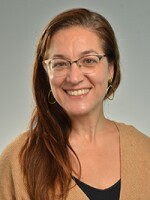Kansas City native Terry Evans has seen things firsthand that most of us never will: a melting glacier crumbling into the waters of Greenland, the breakage of land at fracking sites in North Dakota.
But Evans keeps returning to her pioneering work documenting the Kansas prairie, even though she never intended to become a landscape photographer at all.
"Pictures of landscape didn't inspire me," Evans says. "I saw the grand pictures made by Ansel Adams and I thought they were boring."
It was people and their stories that motivated her.
Evans, whose work is up through June as part of the Spencer Museum's exhibit The Power of Place, has taken her camera into the air all over the world to show people and the planet from a vantage point that's invisible from the ground. Her work is collected by the most revered museums in the country: the Art Institute of Chicago, the Museum of Modern Art, the San Francisco Museum of Modern Art, and the Whitney Museum of American Art.
She began her career in Kansas City, Kansas. There, Evans tried to understand, with her camera, what it meant to live in poverty. With the guidance of a minister, she got to know people, forged relationships, and made pictures.

The eagerness of her subjects to be part of that project sent an important message: "This is OK. People will let me photograph them and they do want to tell me their stories."
Although Evans always planned to study art, photography wasn't her goal until an exciting moment during her senior year in college. In the spring of 1968, Bobby Kennedy came through Lawrence on the presidential campaign trail.
"My father had a beautiful Nikon Camera, which in those days was something that only a professional would have had," she recalls.
Just by virtue of having that camera, Evans looked like a professional and was allowed onto the floor of Allen Field House with credentialed press photographers.
"I discovered that photography could be an interface with the world," Evans recalls. "It was a much different experience than sitting by myself in my studio painting. I really loved thinking that the camera was a way to explore the world ... and gain me access."
The camera was an epiphany. And so was the prairie. It began when she moved with her husband to a farmhouse near Salina after graduating.

"Every morning he would wake up and go to the window on the second floor where our bedroom was. ... And he would say, 'Oh, what a beautiful day it is.' It didn't matter if it was thunderstorms or, or snowing or sleet."
She began taking pictures of the prairie for the Land Institute, where scientists had just begun working on sustainability by studying the self-sufficient prairie ecosystem. She quickly became obsessed with the world that opened up to her there.
"This was vastly different than my own front yard, which was just all the same species of grass. I could stand and look at the ground in front of me for a long time before I would see everything that was growing there."
Evans began to think that if she could understand the prairie, the whole universe would reveal itself to her.

That's the level of understanding she's been chasing with her camera ever since. And after making mind-bending images of locations all over the globe, she lives in Chicago, where she's still trying to crack the code.
Evans has spent the past winter photographing a single oak tree on the South Side of Chicago.
"The Oak Savannah is the ecosystem that is the transition between prairie and forest. It survived and exists because as prairie fires burned through, oak trees would withstand the fires," she says.
"It's a very complicated tree with very winding and interesting branches," she adds. "And I can never quite see the whole thing. So I keep going back and back and back trying to thoroughly see. And maybe if I'm lucky, understand what it's like to be this ancient oak tree."
Portrait Sessions are intimate conversations with some of the most interesting people in Kansas City. You can listen to Gina Kaufmann's entire interview with Terry Evans here.
Gina Kaufmann is the host of KCUR's Central Standard. You can contact her on Twitter, @GinaKCUR.





